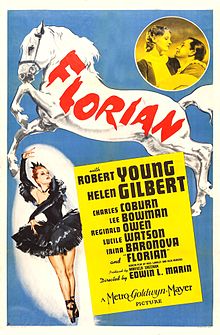Plot
A young groom, Anton, has grown up in Austria a friend of the duchess, Diana, despite their differences in social class. Anton trains a gifted stallion, Florian, for her father, the emperor. Archduke Oliver is the intended husband for the emperor's daughter, but he is killed in battle.
When war ravages the country, Anton is able to assist Diana in crossing the Switzerland border to safety, but he is arrested on returning home. The horse, Florian, is sold to Max Borelli, a carnival worker from New York City who takes him there, then treats him abusively and eventually sells the horse for a fraction of its worth.
Anton is freed and, accompanied by Dr. Hofer, his veterinarian, travels to New York to begin a new life. While he is there, Anton manages to find Florian, return him to good health and make him the splendid horse he used to be. Diana becomes aware of their presence and all are happily reunited.

Franz Joseph I or Francis Joseph I was Emperor of Austria, King of Hungary, and the ruler of the other states of the Habsburg monarchy from 2 December 1848 until his death in 1916. In the early part of his reign, his realms and territories were referred to as the Austrian Empire, but were reconstituted as the dual monarchy of the Austro-Hungarian Empire in 1867. From 1 May 1850 to 24 August 1866, he was also president of the German Confederation.
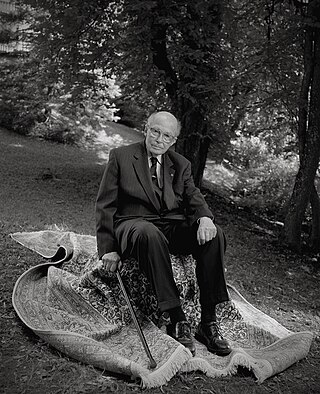
Otto von Habsburg was the last crown prince of Austria-Hungary from 1916 until the dissolution of the empire in November 1918. In 1922, he became the pretender to the former thrones, head of the House of Habsburg-Lorraine, and sovereign of the Order of the Golden Fleece, upon the death of his father. He resigned as Sovereign of the Golden Fleece in 2000 and as head of the Imperial House in 2007.
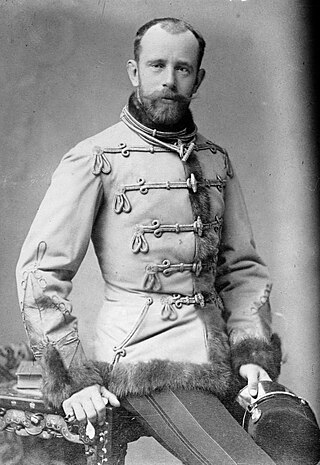
Rudolf, Crown Prince of Austria was the only son and third child of Emperor Franz Joseph I of Austria and Duchess Elisabeth of Bavaria (Sisi). He was heir apparent to the imperial throne of the Austro-Hungarian Empire from birth. In 1889, he died in a suicide pact with his mistress Baroness Mary Vetsera at the Mayerling hunting lodge. The ensuing scandal made international headlines.

Sophie, Duchess of Hohenberg was the wife of Archduke Franz Ferdinand of Austria, the heir to the Austro-Hungarian throne. Their assassination in Sarajevo sparked a series of events that led, four weeks later, to World War I.

The Imperial Crypt, also called the Capuchin Crypt (Kapuzinergruft), is a burial chamber beneath the Capuchin Church and monastery in Vienna, Austria. It was founded in 1618 and dedicated in 1632, and located on the Neuer Markt square of the Innere Stadt, near the Hofburg Palace. Since 1633, the Imperial Crypt serves as the principal place of entombment for the members of the House of Habsburg. The bones of 145 Habsburg royalty, plus urns containing the hearts or cremated remains of four others, are here, including 12 emperors and 18 empresses. The visible 107 metal sarcophagi and five heart urns range in style from puritan plain to exuberant rococo. Some of the dozen resident Capuchin friars continue their customary role as the guardians and caretakers of the crypt, along with their other pastoral work in Vienna. The most recent entombment was in 2023.

Anton Florian was the Prince of Liechtenstein between 1718 and 1721.

The House of Habsburg-Este, also known as the House of Austria-Este and holder of the title of Archduke of Austria-Este, is a cadet branch of the House of Habsburg-Lorraine and also descends from the House of Este in the cognatic line. It was created in 1771 with the marriage between Ferdinand of Habsburg-Lorraine and Maria Beatrice d'Este, only daughter of the Duke of Modena, Ercole III d'Este. After the death of Ercole III in 1803, the Modena ruling branch of the Este family's male line ended, and the Habsburg-Este line subsequently inherited his possessions in what is now Italy.

Robert, Archduke of Austria-Este, was the second son of Charles I, (beatified) last Emperor of Austria-Hungary, and Princess Zita of Bourbon-Parma. He was also known as Robert Karl Erzherzog von Österreich.
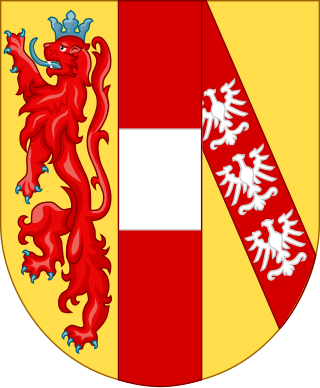
The House of Habsburg-Lorraine originated from the marriage in 1736 of Francis III, Duke of Lorraine and Bar, and Maria Theresa of Austria, later successively Queen of Bohemia, Queen of Hungary, Queen of Croatia and Archduchess of Austria. Its members form the legitimate surviving line of both the House of Habsburg and the House of Lorraine, and they inherited their patrimonial possessions from the female line of the House of Habsburg and from the male line of the House of Lorraine.

Archduke Ludwig Viktor Joseph Anton of Austria was the youngest child of Archduke Franz Karl of Austria and his wife Princess Sophie of Bavaria, and the younger brother of Emperor Franz Joseph I. He had a military career, as was usual for archdukes, but did not take part in politics. He was openly homosexual and declined to marry princesses who were sought for him. He is well-known for his art collection and patronage as well as philanthropy.

Sissi is a 1955 Austrian historical romance film written and directed by Ernst Marischka and starring Romy Schneider, Karlheinz Böhm, Magda Schneider, Uta Franz, Gustav Knuth, Josef Meinrad, Vilma Degischer and Peter Weck. Sissi is the first installment in the trilogy of films about Empress Elisabeth of Austria, who was known to her family as "Sisi". It was followed by The Young Empress and Fateful Years of an Empress.
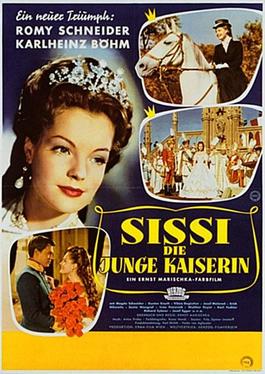
Sissi – The Young Empress is a 1956 Austrian film directed by Ernst Marischka and starring Romy Schneider, Karlheinz Böhm, Magda Schneider, Uta Franz, Gustav Knuth, Vilma Degischer and Josef Meinrad. It was entered into the 1957 Cannes Film Festival. It is the second film in the Sissi trilogy, following Sissi and preceding Sissi – Fateful Years of an Empress. This movie in three parts tells the famous story of the Empress of Austria best known as Sissi.

Sissi – Fateful Years of an Empress is a 1957 Austrian film written and directed by Ernst Marischka and starring Romy Schneider and Karlheinz Böhm, with Magda Schneider, Gustav Knuth, Uta Franz, Vilma Degischer and Walther Reyer. It was entered into the 1958 Cannes Film Festival. The costumes are by Gerdago.

Archduke Felix of Austria was the last-surviving child of Charles I, the last Emperor of Austria, and a member of the House of Habsburg-Lorraine. He was a younger brother of former Crown Prince Otto of Austria, who predeceased Felix by two months.

Archduke Rainer of Austria was a member of the House of Habsburg-Lorraine, a member of the Tuscan branch of the Imperial House of Habsburg, an Archduke of Austria and Prince of Tuscany by birth. He was the eldest son Archduke Leopold Salvator of Austria, Prince of Tuscany. He served as officer in the Austrian army during World War I. At the fall of the Habsburg dynasty, he remained in Vienna and worked for a time as taxi driver. He died unmarried at the age of 34 from blood-poisoning.

The Night Is Young is a 1935 American romantic musical film starring Ramon Novarro and Evelyn Laye. The film is based on a story written by Vicki Baum and directed by Dudley Murphy.
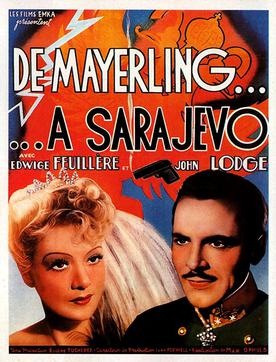
Sarajevo is a 1940 French historical drama film directed by Max Ophüls and starring Edwige Feuillère, John Lodge and Aimé Clariond. Beginning in the aftermath of the Mayerling Incident, the film portrays the love affair and marriage between Archduke Franz Ferdinand of Austria and Sophie, Duchess of Hohenberg, leading up to their eventual assassination in 1914 in events that triggered the First World War. The film was not a commercial or critical success. Following the German occupation of France the film was banned, and Ophüls fled into exile for the second time.

Archduke Heinrich Anton of Austria, was an Archduke of Austria and Lieutenant field marshal.

Florian: The Emperor's Stallion, also published as Florian: An Emperor's Horse and Florian the Lipizzaner, is a 1933 novel by the Austrian writer Felix Salten, made in 1940 to the film Florian. The novel tells the story of a Lipizzan horse during and after the decline of the Habsburg monarchy in Vienna, circa 1901–1930.

The Empress is a German historical drama television series based on the life of Empress Elisabeth of Austria, starring Devrim Lingnau in the title role, and Philip Froissant as Emperor Franz Joseph. It was released on Netflix on 29 September 2022. It was Netflix's second-most watched series worldwide for two weeks and the seventh most popular non-English series of 2022, with over 150 million hours streamed. On 8 November 2022, Netflix renewed it for a second season, which premiered on 22 November 2024. Netflix also commissioned a companion novel, The Empress: A Novel, by Gigi Griffis, which was published two days before the series premiered on the streaming service.
